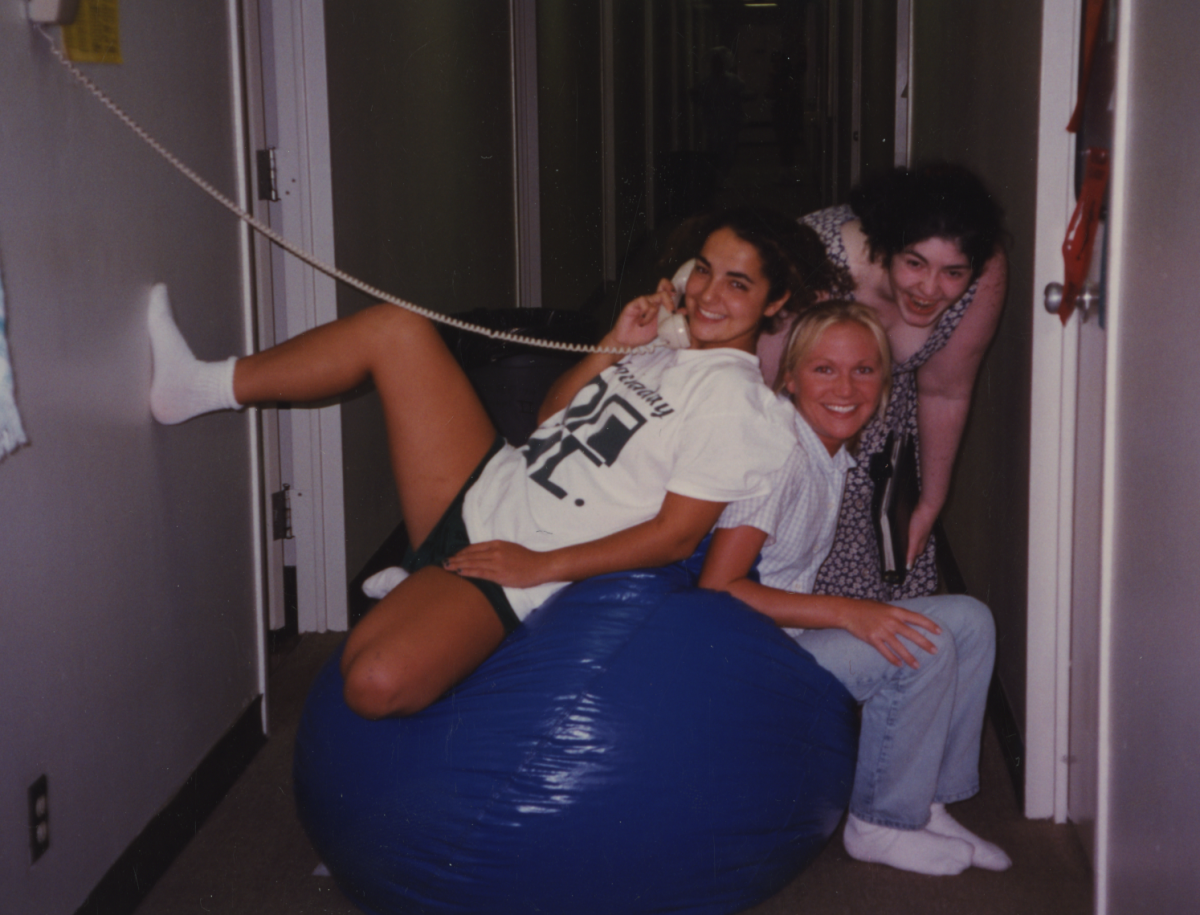Boys. The simple word can cause shrieks of joy or angst from the freshman to the senior hallway.Yet, at an all-girls school, our relationships with the opposite sex are often different than that of ourcounterparts at co-ed schools. This issue, Hockaday Fourcast has taken an in-depth look at these such social relations between boys and girls and how they differ with the all-girls environment.
Friendship
Across the board, boys and girls at both single sex and co-ed schools all look for friendships over relationships or hook-ups when first meeting peers of the opposite sex. Regardless, the notion that guy friends are harder to come by in a single-sex environment, is not unfounded. While 76 percent of Hockaday girls said they found it hard to meet guy friends, only 28 percent of Greenhill girls had the same response in a recent survey given to single sex and co-ed high school students.
“I talk to my guy friends every day, but that being said, it takes a much greater effort to maintain the same level of friendship since I do not see my guy friends as often,” explained one Hockaday upper school student.
Although most Hockaday girls spend time with boys only one to two times a week, they view those friendships as different than but equal to their friendships with girls. “It’s a completely different friendship. That’s not to say its bad or not the same level, but it’s different,” remarked another upper school student.
“My experience wouldn’t lead me to believe that girls in a co-ed environment are more at ease in interacting with boys in a social environment than girls in an all girl environment and I would say the same for boys. I think adolescence sort of trumps all that, [meaning] people are uncomfortable at different degrees no matter what school they go to,” said Head of Upper School, John Ashton who has taught in both co-ed and single sex schools.
For graduates of single-sex schools, college provides the first opportunity for day to day interactions with members of the opposite sex.
Kate, class of ’09, highlights the importance of friendships with boys as a college student. “My immediate instinct is to look for a friend. A guy friend is ten times more important to me than [a relationship with] a boyfriend that might end quickly.”
Upper School History teacher and St. Mark’s graduate, Jim Wasserman, shines a different light on the new co-ed environment. “Even with the girls who I was just friends with in high school, I was very socially awkward. I was very shy,” he said. “I didn’t learn to just relax and have a female as a friend until college.”
Day-to-Day
Going to a restaurant with family or friends and having a young, attractive male waiter shouldn’t be that big of a deal. Yet some girls who attended school in a single-sex environment find day-to-day instances with boys nerve-wracking and awkward. Many Hockaday girls sometimes even feel unprepared for co-ed classes in college and the workplace.
According to numerous studies, including one by Professor Cary Watson of Stanford University, single-sex education is better for girls academically. In Watson’s study, she found that 85 percent of alumnae from all-girls schools believed they received much better preparation for college than if they had attended a co-ed school. Girls in single-sex schools also tend to participate more openly in class and are given the opportunity to assume more positions of leadership.
An all-female learning environment gives girls the chance to take more risks and speak out in class. Additionally, classes that are traditionally viewed as “male” courses, such as math and science, are more frequently tackled in all-girls schools. But though girls may gain confidence in the classroom, respondents to an anonymous survey of Hockaday upper schoolers feel that students lack it in social situations, as many say they feel “self-conscious” and “insecure” when they meet an attractive guy.
“I think it’s a lot harder to maintain friendships with guy friends because I see them so rarely,” a Hockaday student says, “Although it’s kind of like keeping up friendships with people who go to any other school, but still, it shouldn’t be that way with St. Mark’s guys. Close friends and I still meet for lunch or to hang out, but it’s hard to build relationships with people you never see.”
One recent Hockaday graduate says, “Most [Hockaday] seniors have no idea what’s coming in college; they’re not prepared. They have the work ethic and knowledge, but Hockaday doesn’t tell anyone things like how to incorporate family into work life and how being in school with boys might be different.” Another alumna added that once in co-ed college classes, she “found it hard to find boys in college that were intellectual.”
Even after college, girls from single-sex high schools frequently find it difficult to adjust to a work environment while balancing a family. “I like Hockaday’s inspiring environment, but all alumnae I know have had trouble mixing work and family, and not many jobs accommodate a woman busy with a family,” says another Hockaday graduate.
At Hockaday, while there are male teachers, more than half of the faculty and staff is female. But with only 13 female CEO’s compared to the 487 males out of the Fortune 500 companies, it’s mostly men that women are going to be working for in the professional world.
Relationships
The all-female environment can affect dating and relationships. On one hand, some students feel that it is easier to maintain a relationship at a single sex school because there is less pressure to be together 24/7.
“Seeing guy friends in moderation gives you more to talk about when you do see them and ensures that you are not as affected by their annoying tendencies,” says an anonymous Hockaday student.
Nevertheless, many students feel that not seeing boys at school everyday poses more challenges than advantages. It is tough to get to know someone well enough to start up a relationship and equally difficult to continue to get closer to him as the relationship progresses.
Many boys at single sex schools feel the same way. “Being in a relationship is harder [than at a co-ed school],” says a St. Marks sophomore, because “you don’t see each other near as often [and there is] less face to face interaction.”
As a result, some Hockaday girls feel that finding and maintaining a boyfriend takes a lot more effort coming from a single sex school. Girls at Hockaday must actively seek out contact with their significant other. At co-ed schools, couples see each other every day so relationships are able to evolve more naturally.
But a more limited access to boys is not the only reason girls at single-sex schools seem to have a harder time finding relationships. Because the all-female environment teaches students to succeed without male approval, some tend to be much more selective when it comes to choosing a guy.
“Hockaday has made my standards for guys very high,” says Hockaday alumna Kate (’09). “[You don’t] want the guy that doesn’t study or says stupid things in class. You want someone who’s driven.” This idea of high standards stems from the confidence girls in an all-girl’s environment gain. According to Head of Upper School John Ashton, “Girls in all girl environments develop a greater sense of confidence in themselves and a definition of their principles, and the ability to not compromise either of those.”
These high standards might also contribute to the statistic that girls who attend single sex schools are less likely to experience teenage pregnancy. In an article in the Educational Psychologist, social psychologist Anthony Pellegrini writes that relationships between students from single sex schools are less likely to be determined by social standing than are relationships at co-ed schools, which are often based more on status in a clique then on individual characteristics. If everyone else is having sex, a girl from a co-ed school may feel as though she is risking her entire social status by not conforming, whereas a girl from a single sex school may be more confident to say no because she is only jeopardizing her relationship with her boyfriend.
Girls from single sex schools are often “more ‘empowered,’” notes a junior at a co-ed school, “but may not always be as comfortable around guys.”
Nevertheless, psychologists Neville Bruce and Katherine Sanders affirm in an article published in the Journal of Biosocial Sciences that attending an all-male or all-female school will not hinder one’s social abilities. “Students from single-sex schools are not noticeably thwarted by any lack of opportunity or experience in the single-sex school system from experiencing romantic episodes, either at school or later in their early university years.”
An anonymous Greenhill senior adds, “I find it fun to meet girls from single sex schools because they are socially different in a good way.”
The Other Side
Girls have always desired to know exactly what thoughts cross a boy’s mind—whether he’s looking for a relationship or simply friendship. Often times, girls are even left puzzled as to whether a boy really meant it when he said, “I’ll call you,” or why exactly he held the door open for her with a smile. A commonality between the sexes: analyzing and over-analyzing the actions and words of the counterpart.
In a recent survey of Greenhill and Cistercian boys, 74 percent of students said they immediately look for friendship when first introduced to a girl by a peer. “I look for friendship because it’s too soon to tell if a relationship would even work,” an anonymous boy commented. Thirty-seven percent said they looked for a hook up right away. “Often times a relationship will stem from a hook up, but rarely do we go into an introduction looking for a girlfriend, or even a friend,” an anonymous boy at a single-sex school said. Only 17 percent of the surveyed boys said they looked for a relationship at first sight.
Although 50 percent of the boys said they viewed girls at all-girls’ schools the same as co-ed girls, written responses generally showed that the majority of boys viewed them differently. Additionally, the responses given by boys from both single-sex and co-ed schools seemed to have similar opinions regarding girls with a single-sex education.
An anonymous senior at an all boys school says, “Girls from single sex schools seem less high maintenance when compared to their co-ed/public counterparts…but occasionally seem to a bit more aggressive, or possessing odd personality quirks that flourished in a single sex environment rather than being stamped out.” Another senior at an all boys school adds, “They are much more prone to childish drama and are less realistic about relationships than girls at co-ed schools. Additionally, a senior at a co-ed school says, “I view girls that go to single sex schools as sheltered and at times naive in social situations.”
As stated by the National Association for Single Sex Public Education, boys may be threatened by girls that study in single-sex environments because they “are more in control [and] have more autonomy in those relationships.” Even in the work force or in masculine environments, women exhibit an aggressive character in order to present themselves as equals to their male counterparts.
When asked what a female’s place in society is, a junior from a co-ed school joked, “They should stay in the kitchen.” But a student at an all boy school agreed with the joke, saying, “They are genetically inferior…so [they are not equal to men in the workplace].” Therefore, many women feel as though this aggressive character is necessary to prove themselves in the workplace.
Upper School history teacher Jim Wasserman studied in the all-boys environment at St. Mark’s. Looking back, he recalls that single-sex education makes boys “kind of shy and awkward…part of the problem is you only see girls in a social circumstance, not an intellectual one.” How did St. Mark’s boys view Hockaday girls during his time? Wasserman jokes, “Usually with binoculars from far away. Through the trees.”
Socially, there are pros and cons to an all boys education. Some studies have shown that while a single-sex environment may be better for girls, boys learn better when they are with girls, as they are able to better understand the nature of the opposite sex.








